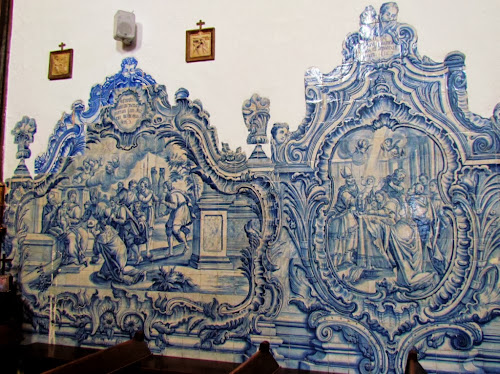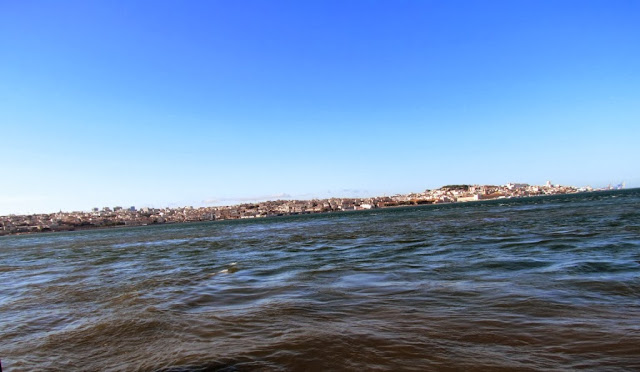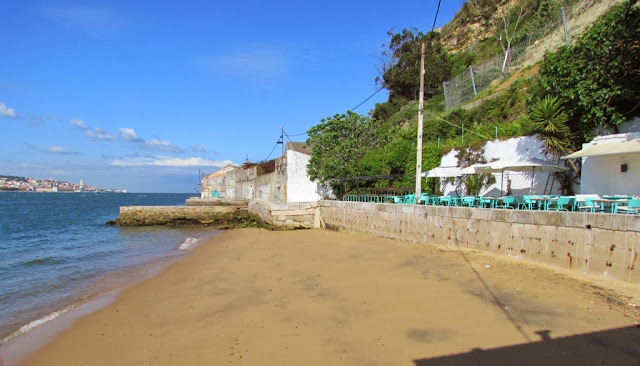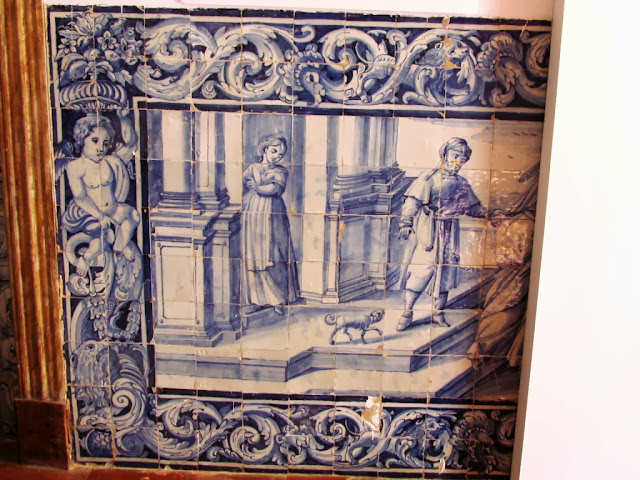CACILHAS
38º 41' 11'' N; 9º 08' 55'' W
Transport
Ferry
Cacilhas is connected by a regular ferry service to the Cais do Sodré railway station on the opposite bank of the river Tagus. Transtejo & Soflusa is the operator.
Lightrail
A terminus for the light rail of the Metro Transportes do Sul is located at Cacilhas. The light rail lines from Cacilhas connect with the Lisbon railway network.
Bus
Bus services depart Cacilhas for the Cristo Rei statue, the beach resort of Costa De Caparica and other destinations.
Maritime Heritage
Dom Fernando II e Glória a wooden-hulled, 50 gun frigate of the Portuguese Navy is on display in a dry dock beside the transport interchange. In 1990 the Portuguese Navy decided to restore the ship to her appearance in the 1850s. She has been on display at Cacilhas since 2008. A submarine is also on display in the adjoining dry dock.
D. Fernando was the last warship entirely sailed by the Portuguese Navy. It was built in Damão, in Portuguese India.
Her inaugural trip, from Goa to Lisbon, took place between February 2 and July 4, 1845.
ALMADA
38º 40' 49'' N; 9º 09' 30'' W
It is the seat of a municipality with an area of 70.21 km² and 174 030 inhabitants (2011), divided into 5 parishes. The municipality is limited to the east by the municipality of Seixal, to the south by Sesimbra, to the west by the Atlantic Ocean, opening to the north and northeast to the Tagus Estuary, in front of the municipalities of Lisbon and Oeiras.
It is one of the oldest administrative divisions in the Lisbon Metropolitan Area. Almada was elevated to the category of city in 1973, and in its municipality is also the city of Costa da Caparica.
Its main point of interest is the National Sanctuary of Cristo Rei.
The municipality of Almada is divided into five parishes:
- Almada, Cova da Piedade, Pragal and Cacilhas (headquarters)
- Caparica and Trafaria
- "Charneca de Caparica" and "Sobreda"
- Costa de Caparica (city)
- "Laranjeiro" and "Feijó" (urban).
Its location at the northwestern tip of the Setúbal Peninsula, on the banks of the Tagus River and in front of Lisbon, makes this, over the years, a strategic military point for the defense and surveillance of the region's trade routes. The Tagus River was a crossing of vessels that exchanged goods such as flour, fruit, fish, wine, etc. Almada and mainly Cacilhas were one of the main ports on the Iberian Peninsula.
In the Middle Ages, in 1147, King D. Afonso Henriques, with the help of the crusades from the countries of northern Europe, conquered Almada, one of the main Arab military squares south of the Tagus.
In 1384, during the Interregnum, Almada was surrounded by the Castilian troops of D. João I de Castela. The population takes refuge within the walls of Castelo de Almada where, prevented from accessing the Fonte da Pipa (the main point of supply of drinking water), it is weakened by the headquarters: the residents are forced to ingest their own urine and water. kneading bread with wine. Almada ends up surrendering.
The 1755 earthquake caused great damage to Almada. Almost all the noble houses collapsed, as did the people's houses. Thousands of people died, were injured, or displaced. The monumental heritage with centuries of history has also collapsed.
Transportation
The Municipality of Almada has promoted a development plan for the transport sector with a view to improving access to the city and mobilization within it.
In 2008, Metro Sul do Tejo appears, an environmentally friendly means of electric transport, which has 3 lines created and 19 stops that connect to other public transport, shopping areas, universities, and areas of high population density.
The city also has two important connection networks with Lisbon, the Fertagus (railway line) that connects by train through the 25 de Abril Bridge and the Transtejo (a waterway) with two connections to the city of Lisbon: Cacilhas - Cais do Sodré and Trafaria - Porto Brandão - Belém.
National Sanctuary of Cristo Rei
In 1959, the city of Almada inaugurated a monument dedicated to the Sacred Heart of Jesus that has become the current famous National Sanctuary of Christ the King. This sanctuary currently forms the golden triangle of the Iberian Peninsula, in religious terms, together with the Sanctuary of Nossa Senhora de Fátima and with the Cathedral of Santiago de Compostela in Spain. It has a 360º panoramic view at 215 meters above sea level, and has become a must-visit for Christian pilgrims every year.
Capuchin Convent and Garden
The Capuchos Convent is an old convent of the Order of Capuchin Franciscan Friars that is located in the Protected Landscape Area of the Arriba Fossil of Costa de Caparica and from which it is possible to observe not only its extensive Caparica beach coast, but even the surroundings, with a splendid view of the Lisbon Coast, Estoril, and Cascais. This convent was built by Lourenço Pires de Távora in 1558. It has the Jardim dos Capuchos around.
Beaches
The extensive beaches of the municipality of Almada (from Costa de Caparica to Fonte da Telha), which cover approximately 13 km of coastline, have excellent conditions for the practice of sea sports such as Surf, Kit-Surf, Windsurf, Bodyboard. Along the beaches, there are several bars and restaurants offering the best of local cuisine. The beaches of Costa da Caparica are the most popular and popular.
Waterfront
Thanks to its location bathed by the Tagus River, it makes the riverside area very interesting for those who pass there. Several restaurants take advantage of the fantastic view over Lisbon and offer typical cuisine, based on fish dishes. The Cacilhas area, the embarkation point for those traveling by boat between Almada and Lisbon, is also an important restoration point in the municipality.
Commercial Area
On September 17, 2002, the Almada Forum Shopping Center was opened in Feijó. Until then, Almada did not have a large commercial area, which made the daily lives of residents and visitors of the city more dynamic.
In 2003 classified as the best shopping center in Europe, its main concern is environmental protection, developing activities, and alerting to matters of interest. With 248 stores, 35 restaurants, and one hypermarket, associated with a free car park.

💓💓💓💓💓
SEARCH IN ALPHABETICAL ORDER
IN THE DISTRICT OF SETUBAL
💓💓💓💓💓
Return to mainland Portugal &
the Azores and Madeira islands






.jpg)





























































